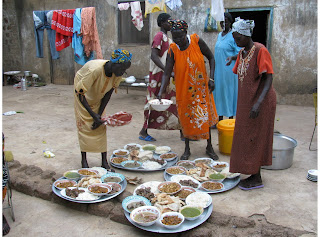My cousin Longar in brown pants and his friends at a small tea and hookah shelter beside the road.
Wau: John Paul High School students playing basketball near the rail suburb.
My Niece, Abuk Aleu lying in front of her friend on the turf grass that adjacent to the Jur River
Wau Bridge: built in 1976 by former Sudanese president “Nummier”. This bridge provides access for local villagers from the other side of Jur River to transport their goods to market, especially during the rainy seasons. But this year in 2009, the area was hit badly by climate changes. The level of water dropped fast; these marks on the bridge pillars have remained to show where the level of water was.
These people in photograph above are, my friends from the neighbouring state of Warrap, studying in Nairobi. Some are sitting for the Kenya Certificate of Secondary Education (KCSE). Others are form two and form three students. The one close to the guy wearing the Ronaldinho T Shirt is my cousin Majok Awar.
My nephew: Majok Achingath walking outside along the street of university of Bhar el Ghazal fence in Wau.
My friend Manyang Athian pose for a photo in front of the corner inside the new shop that still under construction
Near an estuary of the river: on the other of the river bank, stand a group of four men watching the hippo in the water, it is amazing as it emerges blowing water noisely from its nose to warn people not to come any closer and goes under the water every now and then. It needs to come out for grazing as the sun is setting.
Seen above a pic of traditional wedding: members from the groom's family arrived singing the song of praise for the girl with her family, and the clan. The woman wearing the black conical shaped hat made of ostrich feathers, is the groom's brother’s first wife. The guy next to her in the green robe with the white hat, is stepbrother to the groom. And the one in front of the group is the groom’s senior uncle who is the leader for the whole marriage process, mainly on negotiation of the dowry with the bride’s family elders. The woman in the middle of the men in the red dress is hiding herself from camera, because of her dwarf status among the group. The building behind them has a roof torn apart by bullets during the war.
This is a Sorghum field at Maluil village outside Wau Town; the rain is always indispensable here like many other parts of South Sudan, local peasants grow this kind of product just as a subsistence crops for family consumption only. When they ripe men do the harvesting to the already plastered family compound. Where women thresh and winnowed them after they dried to separate the chaff from the grains, and finally they taken to the family granary.
My cousin Majok Ngor on the left, in the middle is my nephew Majok, and uncle Chandit's brother in law. they are having their photo taken in front the portrait of John Bosco in Wau, Vocational Training Centre.(VTC)
Jur River: a local fisherman on his small boat made of palm truck with its front part torn out, checking his net early in the morning to see if there are some fish in the net. 'Unfortunately there is no fish', he said to me. Two years ago, this net would have been full of fish, now the net stays in water for more than two days without catching a single fish. 'Things are changing drastically' he said. The sizes of fish such as tilapia, tiger fish, catfish, nile perch and even the puffer fish has changed. Even people still cross the river on foot due to low level of water in the river ' perhaps our ancestors are unhappy with us, he said, we need to appease them by offering and asking them to help us with enought rain to fill up the river.
In this pic seen above: are Wau-Alve and Mayo primary school students. They are marching to their position in Wau stadium during the late John Garang’s Memorial Day. These are not Muslim schoolgirls, they are Christians, but some schools under Sudanese government funding were forced to wear an Islamic dress code. Behind them on the right side are the Sudanese People Liberation Army (SPLA) and police standing in the parade.
Me: standing at the estuary of the Jur River.




















































